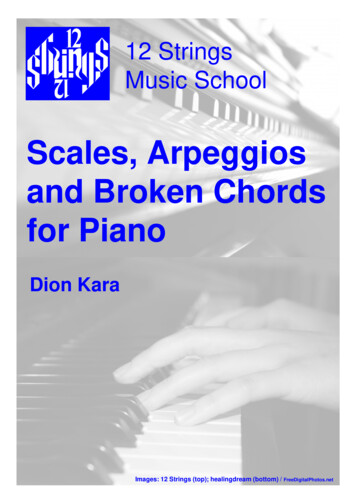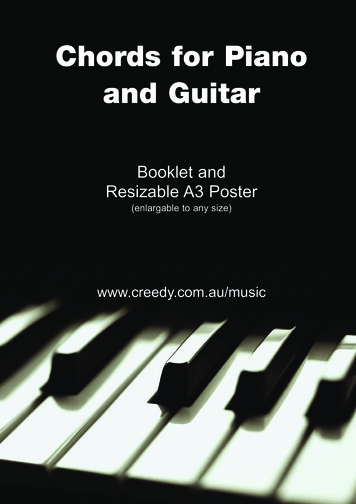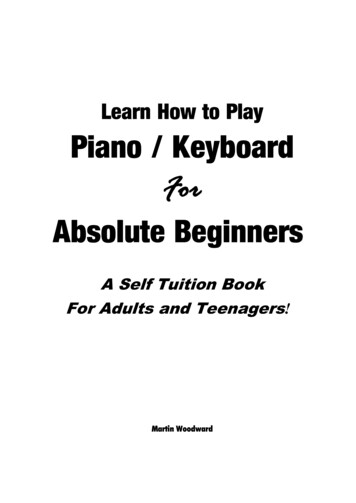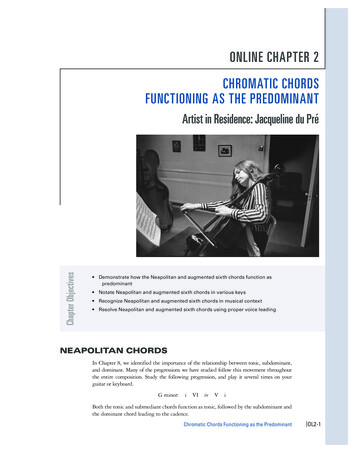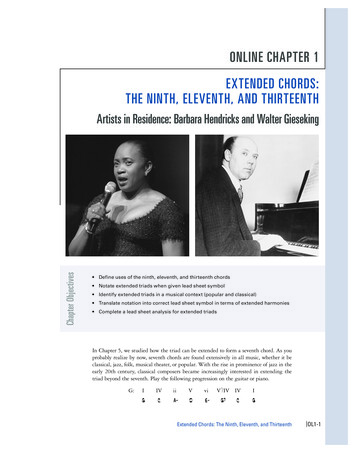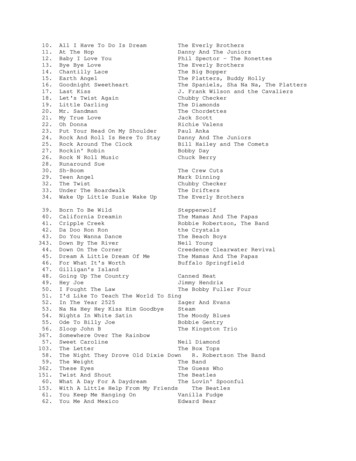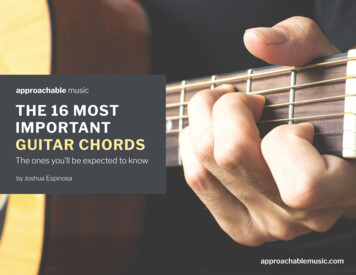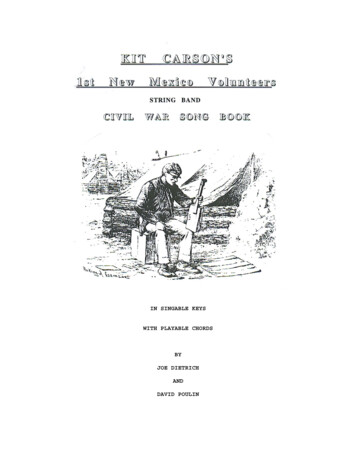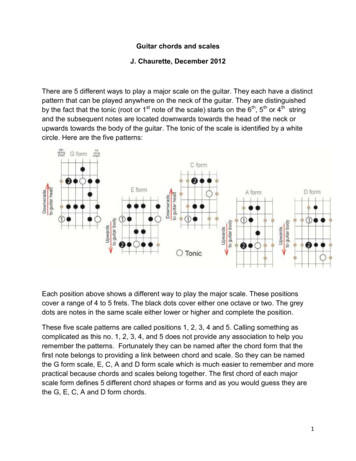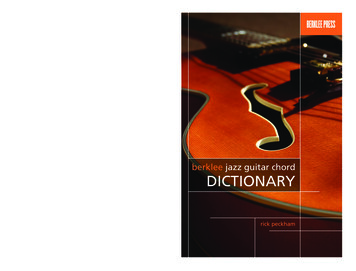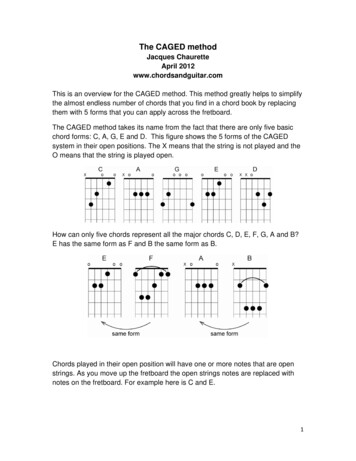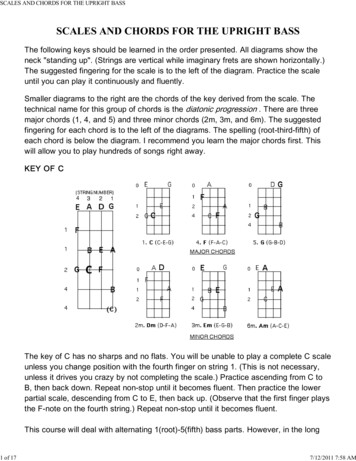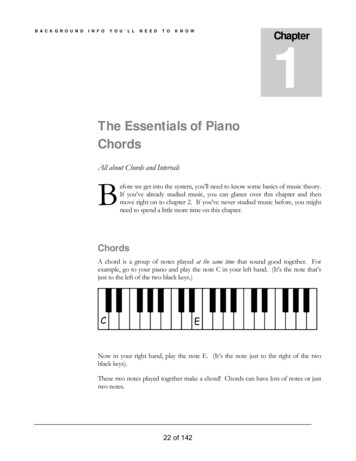
Transcription
B A C K G R O U N DI N F OY O U ’ L LN E E DT OK N O W1ChapterThe Essentials of PianoChordsAll about Chords and IntervalsBefore we get into the system, you’ll need to know some basics of music theory.If you’ve already studied music, you can glance over this chapter and thenmove right on to chapter 2. If you’ve never studied music before, you mightneed to spend a little more time on this chapter.ChordsA chord is a group of notes played at the same time that sound good together. Forexample, go to your piano and play the note C in your left hand. (It’s the note that’sjust to the left of the two black keys.)CENow in your right hand, play the note E. (It’s the note just to the right of the twoblack keys).These two notes played together make a chord! Chords can have lots of notes or justtwo notes.22 of 142
B A C K G R O U N DI N F OY O U ’ L LN E E DT OK N O WFor example, we could add another C to the chord, just below the E, and the chordwould still sound about the same.CCEPlay the top twonotes in the righthand for now.Fingering doesn’tmatter just yet.Certain notes tend to change the flavor of a chord. For example, if we add the note BFlat to the notes C and E, we’ll get a very different sort of sound.B Flat is the right-most of the three black keys. It is written with the flat symbol, whichlooks like a cursive letter b.bBCESo when you add the note B Flat to the notes C and E, you get what’s called a C7chord.In sheet music, you might see it like this:23 of 142
B A C K G R O U N DI N F OY O U ’ L LN E E DT OK N O WWhat you see here are two chord symbols, the symbol for the chord C7 (“pronouncedC Seven”) and the symbol for the chord F. Underneath you see five notes. This is themelody.So what we’ll want to do is play the chord along with the melody note written below it.Often, the melody note will be part of the chord – as we see here. The note E, whichis the first note of the melody, is also the top note of the C7 chord you’ve learned.So you would play those three notes, the C in the left hand, the Bb and E in the right.Then you would play the three melody notes that follow, the D, C and E. You caneither hold down the chord while you play those other notes, or let go of it, dependingon the style and your skill at the keyboard.You would then play the next chord along with its melody note. (We’ll learn the Fchord in a minute.)That’s the essence of how to use chords. Now let’s learn how Chord Symbolsconstructed.HOW CHORDS SYMBOLS ARE BUILT:ROOTQUALITYEXTRA STUFFF#m7b524 of 142
B A C K G R O U N DI N F OY O U ’ L LN E E DT OK N O WRootUsually the bottom note of a chord, the Root is the fundamental note of the chord towhich the other notes relate.7R3Root NoteRelated notesQualityThe next part any chord symbol is the Quality of the chord. This changes dependingon the related notes. For example a C chord has the note E in it, while a Cm chord(pronounced “C minor”) has the note Eb in it.Here’s a C chord.CEHere’s a Cm chord.ECb25 of 142
B A C K G R O U N DI N F OY O U ’ L LN E E DT OK N O WThe quality usually depends on two related notes: the third and the seventh.For example the note E is the third of the note C. The note Eb is the minor third ofthe note C.Major 3rdMinor 3rdWhen you play the Root and the third together, you get a chord. If you play C and Etogether you get a C Major chord (Often just called a C chord – the Major quality isassumed). If you play C and Eb together you get a C Minor chord.The other most important note for determining the quality of a chord is the seventh.The seventh of the note C is the note B. The minor seventh of the note C is the noteBb.(The note B is just to the right of the three black keys.)CB26 of 142
B A C K G R O U N DI N F OY O U ’ L LN E E DT OK N O WWhen you play the Root, the 3rd and the 7th, you get what’s called a seventh chord.CBEThis is a blanket term for all the different types of seventh chords.There are four qualities of seventh chords you will see: the Major 7th chord the Minor 7th chord the Dominant 7th chord The Diminished 7th chordConfusingly the Dominant 7th chord is often the “default” seventh chord, so ifsomeone said to you, “play a C Seven chord,” they would actually mean a dominantchord. Most people don’t use the proper term, dominant, because it’s a long word.To distinguish the dominant from the other chords, these improper folks willdescribe the other seventh chords by their whole name. “Play C seven, and thenplay C minor seven”. You would understand this to mean “Play C dominant, andthen play C minor seventh”.To save yourself from confusion, remember that All “seven” chords are “seventh”chords, but not all “seventh” chords are seven chords.In other words, the dominant chord (which is often called “seven”) is a type ofseventh chord, but not all seventh chords are dominant.The chord above using C, B and E, is a Major 7th Chord. The chord on page twousing C, Bb and E is a Dominant 7th Chord.27 of 142
B A C K G R O U N DI N F OY O U ’ L LN E E DT OK N O WC Major 7th uses the notes B and E in the right hand. C Dominant 7th uses the notesBb and E in the right hand.C Minor 7th uses the notes Bb and Eb in the right hand. C Diminished 7th uses thenotes A and Eb in the right hand.(The note A is the right-most of the two white keys between the three black keys.)ECAbExtra StuffThe “extra stuff” is the third thing you’ll see tacked on after the quality. This is foralterations to the chord or for added-on notes. For example, the symbol C7b5(pronounced “C Seven, flat five”) is just a C Dominant chord with the flat fifth addedon.28 of 142
B A C K G R O U N DI N F OY O U ’ L LN E E DT OK N O WThe flat fifth of any C chord is the note G Flat. It’s the left most of the three blackkeys.GbHere’s a C7b5 chord. Compare it to the C7 chord we talked about earlier. Do you seehow it’s the same chord, just with one added note? That’s the essence of the “extrastuff” part of chord symbols.bGBCEbTry playing thesetwo notes in theright hand, whilethe C and Bb areplayed in the leftNow the extra stuff adds some complexity to what we’re doing, so we’ll leave off theextra stuff for now. If you see C7b5, just play C7. OK? This will make things easier atfirst, and then, whenever you’re ready, you can it back in.29 of 142
B A C K G R O U N DI N F OY O U ’ L LN E E DT OK N O WLearning the Sharp and Flat Note NamesThe black keys on the keyboard don’t have their own names. They borrow theirnames from the keys to the left and right.For example, look below at the notes A and B. B is the note just to the right of thethree black keys. A is the right-most of the two white keys between the three black keys.They have one note in between them, which can be named either B flat or A sharp.In this first diagram you see the sharp names for the black keys. These names comefrom the note just to the left. So C sharp is one key “higher” than C. “Higher” on thekey board means to the right on the keyboard.C#D#F#G#A#F G AC D EBIn this second diagram you see the flat names for the black keys. These names comefrom the note just to the right. So D Flat is one key “lower’ than the note D. “Lower”on the keyboard means to the left.DbEbGbAbBbF G AC D E“Lower pitches”30 of 142B“Higher pitches”
B A C K G R O U N DI N F OY O U ’ L LN E E DT OK N O WOften, you’ll see sharps as the music goes up in pitch (as you move from left to righton the keyboard).Often, you’ll see flats as the music goes down in pitch (as you move from right to lefton the keyboard).Usually a chord is spelled with either all sharps or all flats, not both. So an Eb minorchord would only use flats. You would spell it Eb and Gb, not Eb and F#. Even if F#is much more common way to spell that piano key.An E flat minor chord is spelled with all flats.EbGbYou could also call this a D sharp minor chord. But then you need to spell all of thenotes with sharps.A D sharp minor chord is spelled with all sharps.##DF31 of 142
B A C K G R O U N DI N F OY O U ’ L LN E E DT OK N O WThe Intervals You’ll Need to KnowThe method this book will teach you requires you to know a few intervals. Intervalsare the distances between notes.First of all, you’ll need to know half-steps. Half-steps are the smallest interval.Basically from any one key to the next key is a half-step – regardless or whether thatkey is a white or black key.Here are some examples of half-steps. C to C# is half-step. D to D# is a half-step. E to F is a half-step. D# to E is a half-step.C#D#C D EF#G#F G AA#BThis is what half-steps look like.So it doesn’t matter whether the key is white or black, as long as it’s adjacent, thedistance is a half-step.32 of 142
B A C K G R O U N DI N F OY O U ’ L LN E E DT OK N O WThe next interval you’ll need to know is a whole-step. A whole-step is basically twohalf-steps. Whole-steps have one key in between them.For example C to D is a whole-step (C# is in between) D to E is a whole-step (D# is in between) E to F# is a whole-step (F is in between) F# to G# is a whole-step (G is in between)C#D#C D EF#G#F G AA#BExamples of whole-steps. Notice most whole steps either go from a white key to awhite key, or a black key to a black key. They’re a little tricky around the notes E and Fbecause there is no black key in between. So, these ones use both white and blackkeys. The same is true between B and C, although you can’t see it on this diagram.Here are some of the trickier whole-steps that use both white and black keys. Eb to F E to F# Bb to C B to C#33 of 142
B A C K G R O U N DI N F OY O U ’ L LN E E DT OK N O WThe last interval you’ll need to know for the system, and the most important one, is thefourth.Fourths have four keys in between.DbEbC D EGbAbF G ABbBSo for example, C to F is a fourth (Db, D, Eb and E are in between) D to G is a fourth (Eb, E, F and Gb are in between) F to Bb is a fourth (Gb, G, Ab, and A are in between)Two Easy Tricks for Finding FourthsBetween White KeysTo find a fourth between white keys, just skip two white keys. So for example: To find a fourth above C, skip two white keys (D and E) and you’ll find thefourth, F. To find a fourth above D, skip two white keys (E and F) and you’ll find thefourth, G.Just watch out for the one exception! F to B is not a fourth. See below underExceptions.34 of 142
B A C K G R O U N DI N F OY O U ’ L LN E E DT OK N O WBetween Black KeysTo find a fourth between black keys, just skip one black key. So for example: To find a fourth above Db, skip one black key (Eb) and you’ll find the fourth,Gb. To find a fourth above Eb, skip one black key (Gb) and you’ll find the fourth,AbJust watch out for the one exception! Gb to Bb is not a fourth. See below underExceptions.ExceptionsThere are two exceptions to our trick for finding fourths. Here they are.Exception 1If you use the trick for white keys starting on F, it doesn’t work. This is the oneexception to the white key rule.F to B is not a fourth! The “skip two white keys” rule will mislead you here. You justhave to memorize this exception.FBThe fourth above F is Bb.BbF35 of 142
B A C K G R O U N DI N F OY O U ’ L LN E E DT OK N O WException 2If you use the trick for black keys starting on F# (or Gb – same note just spelleddifferently) it doesn’t work. This is the one exception to the black key rule.F# to A# (or Gb to Bb) is not a fourth! The “skip one black key” rule will misleadyou here. You just have to memorize this one exception.F#A#The fourth is F# to B!F#BHere’s a list of fourths. For homework, see if you can find them all on the piano: C to F C# to F# D to G Eb to Ab E to A F to Bb – (exception to the white key rule) F# to Bb – (exception to the black key rule) G to C G# to C#36 of 142
B A C K G R O U N D Ab to Db A to D Bb to Eb B to EI N F OY O U ’ L LN E E DT OK N O WThe Essential Elements of a ChordSo far we’ve talked about the Root, the 3rd and the 7th. The Root is the foundation ofthe chord around which the other notes relate. The 3rd and 7th are the notes thatdetermine the quality of the chord.There is one more element of the chord that you will see much more in other chordbooks, but I try to minimize, and that’s the fifth. The fifth is not an essential elementof the chord. You will often see it in other chord books because they teach you thechords in terms of triads. Triads are chords that use the Root, 3rd and 5th (all threenotes are third away from one another, hence the name triad).The fifth helps strengthen a chord and make it more powerful, but it can also causeproblems as far as voice leading, and until you are more advanced, I wouldrecommend leaving it out. Eventually, when your ear is stronger, you’ll sense whenyou should add a little fifth, or when you should leave it out.On the following pages, we’ll review the essential elements of a chord and how to findthem.37 of 142
B A C K G R O U N DI N F OY O U ’ L LN E E DT OK N O WThe ThirdThe third is the next most essential note in a chord after the root. In fact, you canmake a chord with simply the root and 3rd. Remember the 3rd for C Major? Thanksright, E.R3Root NoteThe thirdMajor Thirds and Minor ThirdsThirds can either be higher or lower in pitch. If they are higher in pitch, they will bemore to the right on the keyboard.R3Major 3rd is further to theright on the keyboardRoot NoteAnd if they’re lower in pitch, they’ll be more to the left on the keyboard.3RRoot NoteMinor 3rd is further to theleft on the keyboard38 of 142
B A C K G R O U N DI N F OY O U ’ L LN E E DT OK N O WFinding the Minor or Major 3rd of a chordIn this book we’ll be learning to find the 3rds of your chord by first finding the 4th andthen counting down either a half-step or whole-step.This is why we needed to learn how to find fourths!The minor 3rd will be down a whole-step from the 4th3R4The 4thRoot NoteMinor 3rd is down a wholestep from the 4thThe major 3rd will be down a half-step from the 4thR3 4The 4thRoot NoteMajor 3rd is down a halfstep from the 4th39 of 142
B A C K G R O U N DI N F OY O
The Essentials of Piano Chords All about Chords and Intervals efore we get into the system, you’ll need to know some basics of music theory. If you’ve already studied music, you can glance over this chapter and then move right on to chapter 2. If you’ve never studied music before, you might need to spend a little more time on this chapter. B Chords A chord is a group of notes played at .
